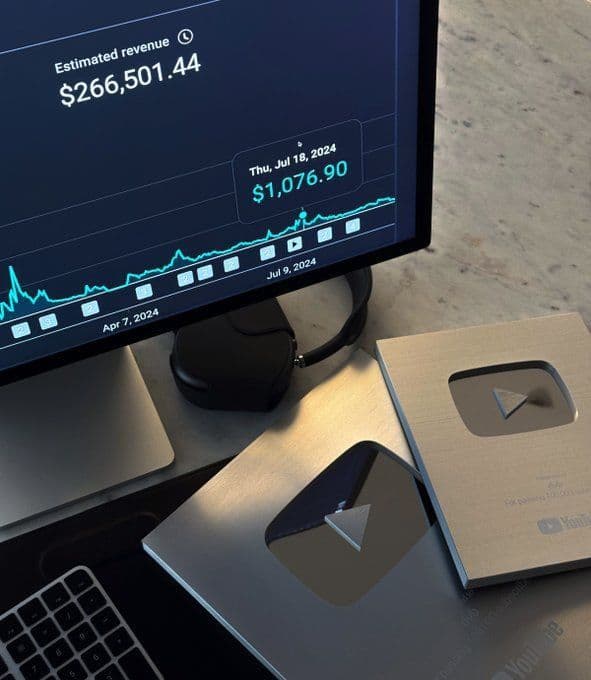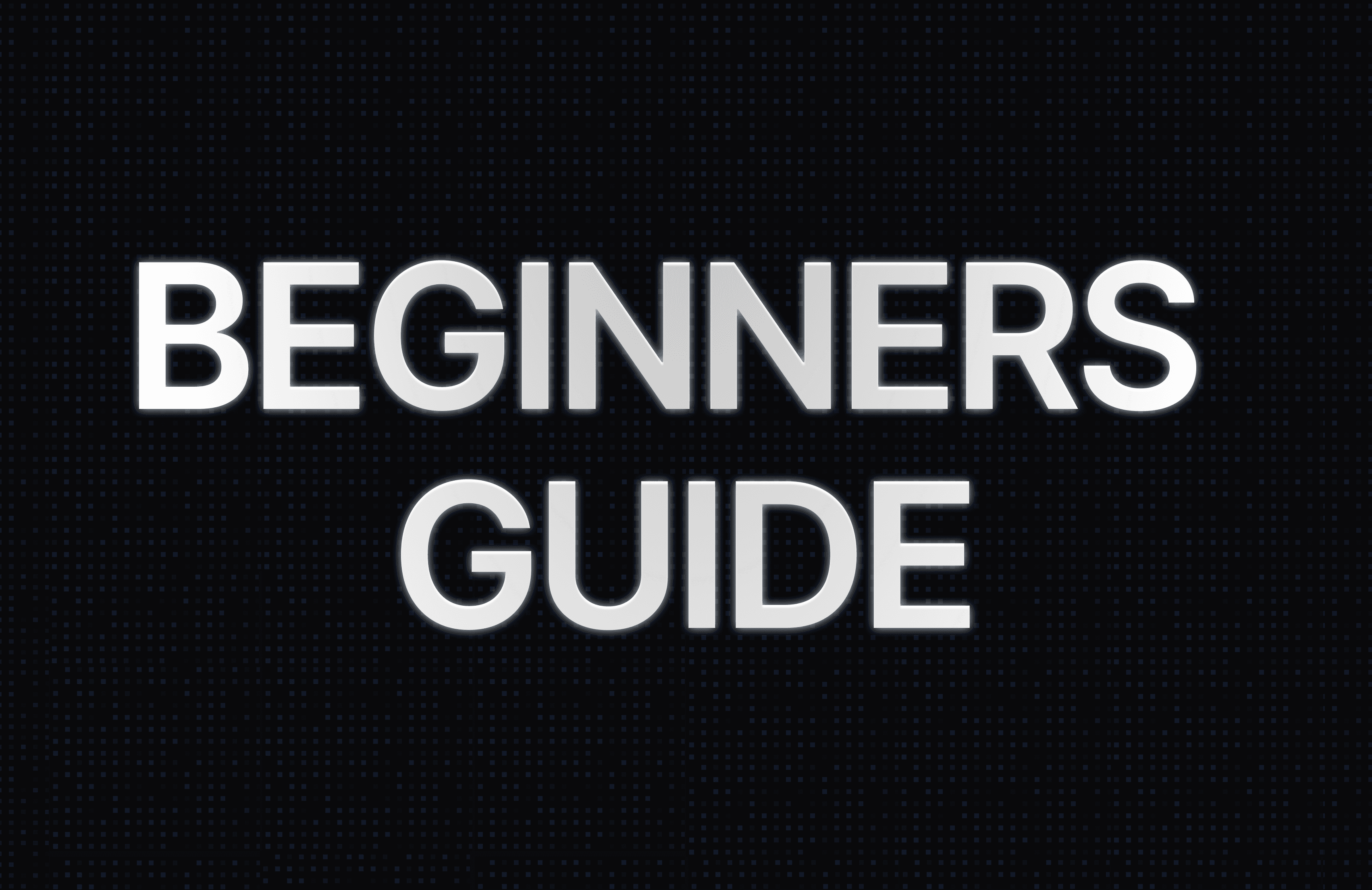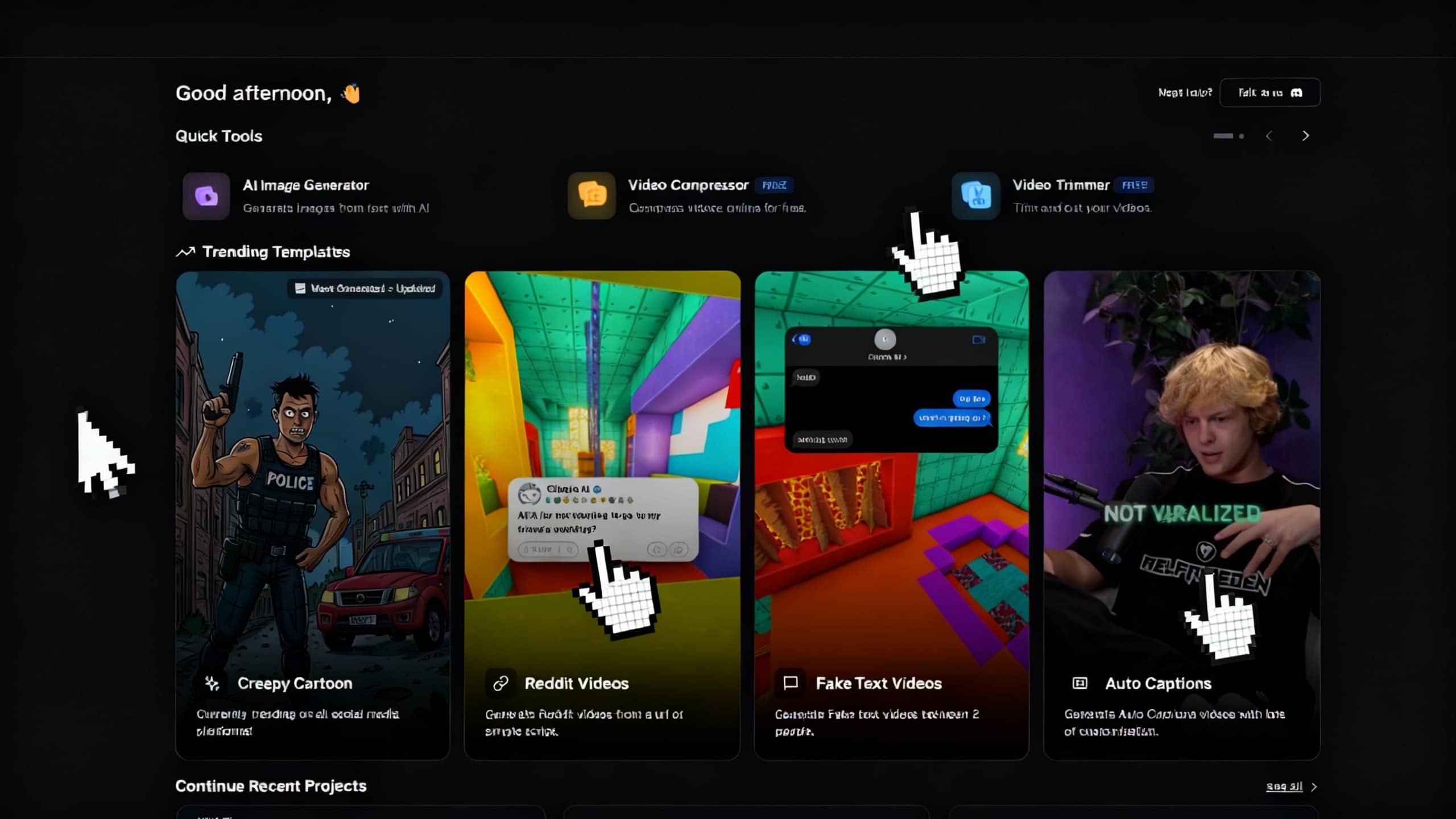How to Clip Content for Money: A Comprehensive Guide
This blog is your comprehensive, step-by-step guide on how to clip content for money in 2025 even if you’re starting with no audience, no editing experience, and no on-camera presence.

Introduction: Why Clipping Is the New Frontier for Content Monetization
In 2025, attention is the new currency and short-form content is the fastest way to earn it. TikTok, Instagram Reels, YouTube Shorts, and even LinkedIn and Pinterest are now optimized to favor bite-sized, scroll-stopping content that delivers impact in seconds. As a result, a new strategy has taken center stage: clipping.
Clipping is the practice of turning longer-form content—like YouTube videos, livestreams, podcasts, interviews, Zoom calls, or webinars—into high-performing short clips that attract more views, more engagement, and ultimately, more money.
But what’s changed in recent years is this:
Clipping no longer requires heavy editing or advanced skills. Thanks to AI-powered platforms like Clippie AI, creators can now automate large portions of the process from subtitles and voiceovers to monetization overlays and platform-specific exports.
It’s no longer just influencers or YouTubers profiting from clips. Anyone from students to agency owners—can clip content for clients, affiliate commissions, or passive income.
Platforms are rewarding clips like never before. Whether it’s the TikTok Creativity Program, YouTube Shorts ad revenue sharing, or sponsored content integrations on Reels there are now multiple monetization opportunities for creators of all sizes.
This blog is your comprehensive, step-by-step guide on how to clip content for money in 2025—even if you’re starting with no audience, no editing experience, and no on-camera presence.
You’ll learn:
What the clipping economy is and why it’s booming.
The top platforms that pay for short-form clips.
A step-by-step setup guide to start clipping today.
Strategic tips for maximizing income from your clips.
The biggest mistakes to avoid.
What the future of clipping looks like in the next 12–24 months.
Whether you’re a solo creator, a marketer, or someone looking to build a faceless digital income stream, this guide will show you how to turn everyday content into cash-generating assets. Monetization Strategies: Turning Clips into Revenue Streams
If you're investing time in creating short-form clips, the ultimate goal is simple: get paid. Whether you’re a beginner or a seasoned creator, understanding how to monetize your clips across different platforms is essential to turning your creative output into a scalable income stream.
Below are the top monetization strategies used by successful clippers in 2025:
1. Platform Payouts (CPM-Based Revenue)
Platforms like YouTube Shorts, TikTok, and Facebook Reels now offer direct monetization options for short-form content. These include:
YouTube Shorts Revenue Sharing: YouTube shares ad revenue from Shorts ads with creators. To qualify, aim for:
10M+ Shorts views over 90 days, or
1K subscribers and 4K watch hours on long-form content.
TikTok Creativity Program (or Creator Fund 2.0):
Pays based on qualified views, content originality, and engagement.
Niches like finance, health, and tech often earn higher CPMs.
Facebook & Instagram Reels Play Bonus (Invite-only):
Offers creators monthly payouts for top-performing Reels.
Requires professional dashboards and often business accounts.
💡 Tip: Prioritize high-retention niches like productivity, tech tutorials, storytelling, fitness tips, and AI tools. These attract premium advertisers, resulting in higher Cost Per Mille (CPM) rates.
2. Cross-Platform Optimization
Don’t let a great clip live on just one app. Repurpose and re-upload content across multiple platforms to multiply reach and revenue:
Upload to TikTok, YouTube Shorts, Instagram Reels, Facebook Reels, Pinterest, and even Snapchat Spotlight.
Adjust captions, hashtags, and descriptions to fit each platform’s SEO and trend dynamics.
Use scheduling tools or Clippie AI’s auto-export feature to batch publish across platforms with minimal manual work.
📈 Why it matters: Algorithms behave differently—what flops on TikTok might explode on YouTube Shorts.
3. Affiliate Marketing (Passive Income Potential)
Integrate affiliate links into your short clips to promote products, tools, or services:
Use Link-in-Bio tools (like Linktree or Beacons) to host affiliate products.
Include low-lift CTA overlays (LLCTAs) like:
“Link in bio for the mic I use.”
“Swipe up for the tool that saved me 10 hours.”
Add Reels stickers and TikTok link pins to drive traffic to your affiliate offers.
💸 Popular affiliate niches:
Podcasting gear
AI tools (e.g., Clippie AI)
Online courses
SaaS products
🔥 Pro Tip: Pair clips with list-style videos like “Top 5 Creator Tools” and link all tools in the bio using affiliate links.
4. Sponsored Clips and Brand Collaborations
Once you build a small but engaged audience (even just 1,000–5,000 followers), brands in your niche may be open to micro-influencer partnerships.
Ways to attract brand deals:
Create a short-form media kit using Canva or Notion.
Reach out directly to niche brands (e.g., productivity tools, camera gear, skincare).
Include clip-specific metrics:
Average views
Engagement rate
Saves and shares
Completion rate
✅ Example Pitch:
“Hey [Brand], I’ve been using [Your Product] in my faceless videos on Reels and Shorts, averaging 50K+ views per post. I’d love to create a short-form series around your product for my audience. Open to collaborating?”
5. Digital Product Funnels
Turn your clips into top-of-funnel traffic machines for your digital products:
Create a free lead magnet (like a Notion template or checklist).
Link the freebie in your bio → trigger an email signup.
Use an automated funnel (via ConvertKit, Gumroad, or Flodesk) to upsell:
eBooks
Mini-courses
Memberships
Coaching sessions
📌 Strategy example:
Create a “Top 5 Tools for TikTok Creators” clip → Link to your free guide → Email funnel sells a $49 TikTok scripting course.
6. Fan Support & Creator Economy Tools
Engage your loyal audience and offer them ways to support your work directly:
YouTube Super Thanks / Super Chat
TikTok Gifts during Lives
Patreon or Ko-fi memberships
Sell behind-the-scenes content, templates, or private group access
🔁 Combine recurring fan support with regular content to build monthly income predictability.
Bonus Strategy: Use Analytics to Secure Partnerships
Data sells. After 10–15 published clips, start tracking key analytics:
Average views per clip
Top 3 highest performing videos
Watch-through rate
Save/share rate
Use these metrics to:
Pitch UGC deals (user-generated content)
Negotiate higher affiliate commissions
Justify sponsored pricing rates
📊 Tools that help:
TikTok Creator Center
YouTube Studio
Instagram Insights
Clippie AI (built-in tracking for engagement-based templates) Avoiding Pitfalls: Common Mistakes That Kill Your Clipping Income
Clipping is one of the easiest entry points into content monetization in 2024 and beyond, but it’s also filled with traps that can limit your reach, get your account shadowbanned, or worse — demonetized.
Below are the most common clipping mistakes creators make — and how to avoid them to stay ahead:
1. Ignoring Platform-Specific Guidelines
Every platform has unique content policies and monetization rules. Violating them can result in:
Account restrictions
Content takedowns
Loss of monetization privileges
✅ How to stay safe:
Don’t use copyrighted music outside of approved libraries.
Avoid misleading thumbnails or clickbait CTAs.
Stay within the community guidelines of TikTok, YouTube Shorts, and Instagram Reels.
Use platform-native tools when possible (e.g., in-app music, stickers, etc.).
🛑 Example to avoid:
Uploading TV show clips without transformation or commentary = copyright strike risk.
2. Posting Inconsistently
The TikTok and Shorts algorithms favor consistent activity over random spikes in uploads.
📉 Common mistake:
Posting 5 videos in one day, then nothing for two weeks.
✅ Solution:
Batch produce content using tools like Clippie AI.
Create a content calendar: 1–3 clips per day or 15–20 per week.
Use scheduling tools or automation features built into your video creation software.
💡 Tip: Even short-form creators benefit from a posting rhythm. Consistency builds algorithm trust.
3. Overcomplicating the Editing Process
Slick transitions and effects may look cool, but they’re not required — and often hurt retention.
📉 Pitfall:
Spending 4+ hours manually editing a 30-second clip when the ROI isn’t worth it.
✅ Instead:
Focus on script, hook, and pacing — the true drivers of virality.
Use AI editors like Clippie AI to handle voiceovers, captions, and visual pacing.
Keep intros tight and avoid overloading viewers with flashy animations.
🔥 Data shows that simple, story-driven content outperforms overly polished edits on TikTok and Reels.
4. Neglecting Captions and Text Overlays
70% of users watch short-form videos with sound off — especially during work hours or commuting.
📉 Mistake:
Posting a clip with no captions or unclear context.
✅ Fix:
Add auto-captions using tools like Vsub or Clippie AI.
Use text overlays to emphasize value (“Hack #3 changed everything 👇”).
Highlight key words or emotional beats to improve readability and retention.
💡 Captions boost:
Watch time
Accessibility
Engagement (likes, saves, shares)
5. No Clear Call-to-Action (CTA)
Viewers scroll fast. Without a clear CTA, they move on — even if they loved the video.
📉 Missed opportunity:
“Cool video!” – but the viewer didn’t know what to do next.
✅ Use strong CTAs like:
“Follow for daily tips.”
“Watch till the end for the bonus hack.”
“Grab the free guide in my bio.”
“Drop a 🔥 if this helped.”
Even faceless creators can use voiceovers, text popups, or overlay templates to include CTAs.
6. Copy-Pasting Without Strategy
Uploading the same clip to multiple platforms without optimization can reduce its effectiveness.
📉 Mistake:
Uploading TikTok clips with watermarks onto Reels or Shorts = shadowban risk.
✅ Fix:
Remove watermarks using tools like SnapTik or native exports via Clippie AI.
Adapt each clip to the platform’s aspect ratio, caption style, and trending audio.
Use platform-specific hashtags and descriptions to maximize discoverability.
7. Failing to Analyze and Iterate
Clipping is a data-driven game. Blind posting = missed growth opportunities.
📉 Common mistake:
“I’m posting, but nothing is going viral.”
✅ Action plan:
Track KPIs: views, watch time, save rate, shares, retention.
Double down on your top-performing formats.
Rework your lowest performers using new intros or shorter runtimes.
Use analytics dashboards (TikTok Creator Tools, YouTube Studio, Clippie AI’s built-in analytics) weekly.
💡 Tip: Just 5–10 high-performing clips can build you a monetizable audience. Learn what works, then replicate.
8. Avoiding Niche Consistency
Trying to go “viral for everything” usually results in nothing going viral at all.
📉 Mistake:
One day it’s cooking, next day AI tools, then personal vlogs.
✅ Strategy:
Pick a clear niche aligned with a target audience:
Productivity hacks
Creator economy
Tech reviews
Mental health & wellness
Stick to 1–2 core formats (e.g., Top 5 lists, “Did you know” reels).
🎯 Niche consistency = algorithm predictability = long-term growth.
9. Ignoring Community Engagement
Short clips may feel impersonal, but comments and DMs are gold mines for content ideas and loyal followers.
📉 Mistake:
Ignoring or never replying to comments.
✅ Win:
Reply to every early comment within the first 30 minutes of posting.
Pin valuable questions or comments.
Use audience questions as future clip ideas.
Build a recognizable brand voice, even if you’re faceless.
10. Not Using Automation Tools
Manual clipping, editing, and exporting might work short-term — but it’s not scalable.
📉 Burnout risk:
Spending hours daily just to keep up.
✅ Solution:
Use AI tools like Clippie AI for:
Auto-script writing
Voiceovers
Captions
Batch creation + export
Automate your entire production workflow so you can focus on strategy and monetization.
🎯 Creators who automate create more content, more consistently which means more chances to go viral and earn. Future Outlook: Why Clipping Will Keep Dominating in 2025 and Beyond
The creator economy is evolving fast — but one trend is crystal clear: clipping isn’t going anywhere. In fact, it’s becoming even more powerful, profitable, and necessary as platforms and algorithms continue to reward short-form, high-retention content.
Here’s what to expect — and how to future-proof your content strategy:
🔮 1. Short-Form Attention Will Keep Rising
Attention spans are shrinking. The average user scrolls through 100+ videos a day.
Platforms like TikTok, YouTube Shorts, and Instagram Reels are increasing algorithmic prioritization of videos under 60 seconds.
More brands and advertisers are leaning into micro-content because of its high conversion rates and repeat viewability.
📈 Takeaway: Short-form clips will continue to outperform long-form content for growth and engagement, especially for new and faceless creators.
🤖 2. AI Will Replace Manual Editing Entirely
AI-powered platforms like Clippie AI and AIcut are changing the game by generating entire videos from prompts or scripts — including:
Captions
Voiceovers
B-roll overlays
CTAs and monetization elements
By 2025, manual editing will be optional, not required. Creators will go from idea → video → upload in minutes.
💡 Expect to see creators using AI to:
Produce 5–10 videos a day
Test new niches at scale
Split-test hooks, captions, and formats automatically
💸 3. Monetization Will Expand Beyond Platform Payouts
While TikTok Creator Rewards and YouTube Shorts payouts exist, they’ll never be the biggest income source.
The real money is in:
Affiliate marketing
Course sales and info products
UGC deals and brand partnerships
Monetized email lists and communities
Clipping will become a lead-gen machine, funneling viewers into higher-ticket offers.
🔥 Smart creators will stop relying only on CPMs and start building ecosystems around their clips.
🌍 4. Global Growth Will Explode
With increasing smartphone penetration in emerging markets, platforms like TikTok are expanding aggressively in Southeast Asia, Africa, and Latin America.
This unlocks huge new audiences — and competition.
Faceless, short-form content transcends language barriers.
✅ Future-proof your strategy by:
Using universal themes (e.g., motivation, humor, tech hacks)
Using captions + minimal voiceover
Creating content that’s easily translatable or remixable
📲 5. Clipping Will Integrate with Every Major Platform
New verticals are opening:
Pinterest Video Pins
LinkedIn Reels (in development)
Threads and Twitter expanding short video reach
Clipping won’t just be for “entertainment” — it’ll dominate:
Education
Business tips
Fitness routines
AI tutorials
Finance advice
📌 Creators who master clipping now will be ahead when every platform adopts this format.
🚀 6. Clipping = Scalable Personal Branding
Whether you’re building a faceless channel or a personality-based brand, clipping allows you to:
Show up daily
Test ideas rapidly
Stay top-of-mind across multiple platforms
No need for professional filming, gear, or big teams.
Just ideas + automation = growth.
🧠 Smart creators in 2025 will focus less on “perfect” content and more on volume, consistency, and optimization — all made possible through clipping.
🎬 7. The Rise of Faceless Empire Builders
You don’t need to show your face or even speak to earn in the new creator economy.
Faceless brands are scaling with:
Niche-based TikTok pages
YouTube Shorts channels
Instagram Reels highlights
Automated AI content (powered by Clippie AI)
💼 Whether you’re an entrepreneur, student, or marketer, clipping allows you to:
Build influence without burnout
Monetize knowledge or trends
Diversify income streams without scaling a personal brand
✅ Final Thoughts: Clip Smarter, Grow Faster
We’re entering a golden era where creators are media companies and short-form clips are the fuel that powers them.
By understanding how to clip content strategically, monetize it intentionally, and automate it intelligently, you can:
Build multiple income streams
Grow a loyal audience
Scale your brand with or without showing your face
🎯 The path is clear: Start small, stay consistent, use the right tools (like Clippie AI), and grow as you learn. Whether you're clipping for fun, side income, or full-time brand building - now is the time to start.
Read more

The Ultimate Beginner’s Guide to Clippie AI (2025): Plans, Credits, Top-Ups, and How It All Works
Learn all about Clippie AI in 2025, including subscription plans, AI credits, and top ups, to help you create faceless videos quickly and grow your content effortlessly.

Building a Viral Workflow with Clippie AI (2025 Edition)
Learn how to build a viral, automated content workflow using Clippie AI. Discover daily systems, templates, and monetization workflows that help creators scale across TikTok, YouTube, and Instagram.

Recap: The Best AI Video Creation Trends from 2025 (And What's Next for 2026)
Complete recap of 2025's biggest AI video creation trends and expert predictions for 2026. Discover how AI tools like Clippie transformed video workflows forever.